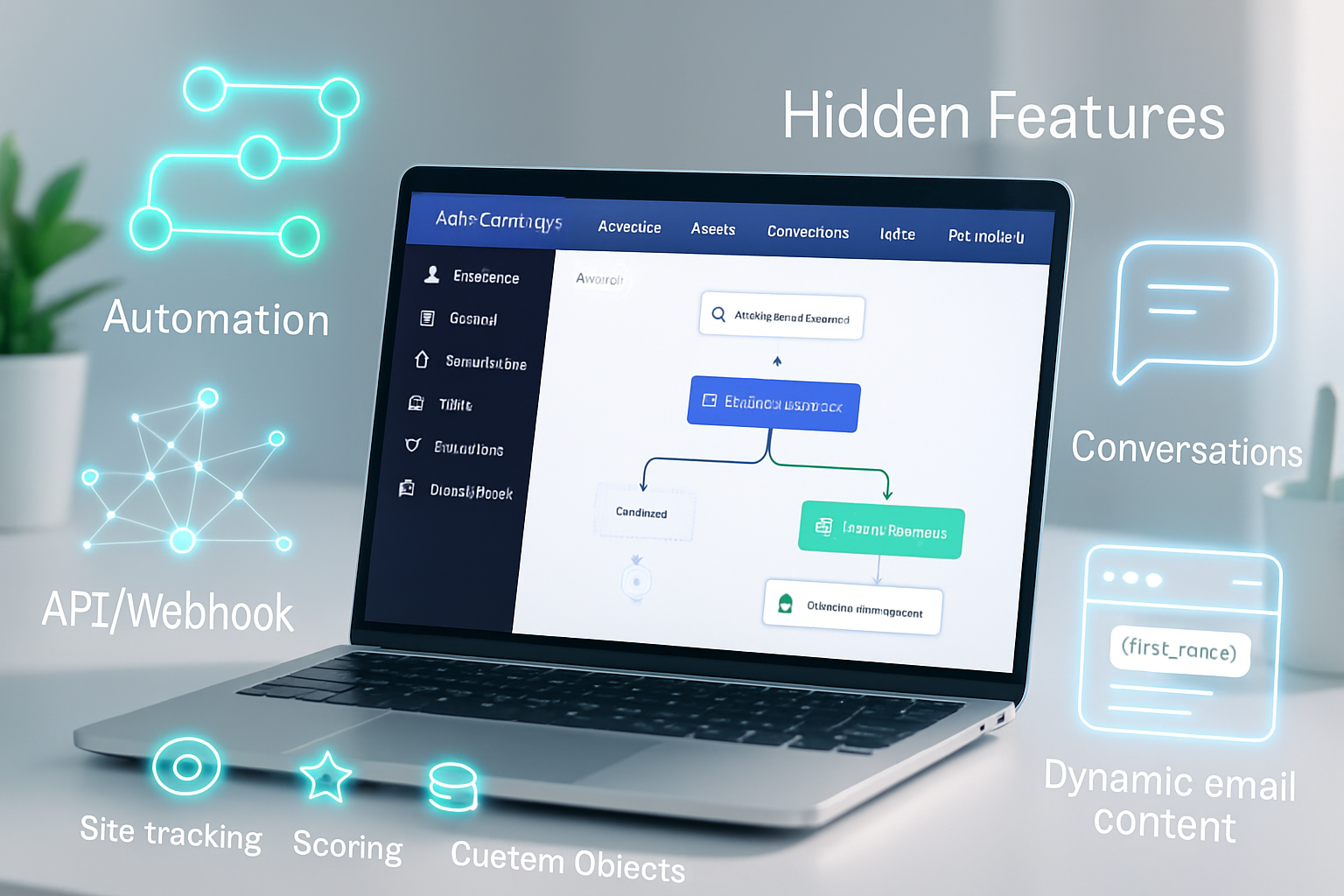· marketing · 7 min read
The Dark Side of Automation: ActiveCampaign Pitfalls to Avoid
Automation should save time and scale personalization - but in the wrong hands it destroys deliverability, damages brand trust, and creates operational chaos. Learn the common ActiveCampaign automation mistakes marketers make and practical ways to avoid them.

What you can get from this article
Automation should let you send the right message, to the right person, at the right time - without manual work. Read this to stop making the automation mistakes that cost you opens, clicks, and customer trust. By the end you’ll be able to audit an ActiveCampaign automation, fix the five biggest failure modes, and implement guardrails that keep your programs healthy.
Short summary first: automation saves time. Bad automation costs revenue.
Why this matters (fast)
Automation amplifies whatever behavior you programmed. If your logic is clean, you scale relevance and revenue. If it’s sloppy, you scale problems: spam complaints, irrelevant follow-ups, angry customers, broken experiences, and worse - compliance risk.
ActiveCampaign is powerful. That power encourages complexity. Complexity hides failure. Most marketers don’t notice until deliverability tanks or a customer posts a screenshot of a ridiculous email thread.
TL;DR - Top pitfalls and fixes
- Pitfall - Over-automation and robotic sequences. Fix: Add human checkpoints and clear exit paths.
- Pitfall - Bad triggers that fire too often. Fix: Tighten trigger logic and de-duplicate with goals or wait conditions.
- Pitfall - Lazy segmentation (everyone gets everything). Fix: Build meaningful segments and use conditional content.
- Pitfall - Broken personalization (empty or incorrect merge fields). Fix: Validate data and set fallbacks.
- Pitfall - Tag chaos and trigger storms. Fix: Use naming standards and tag hygiene processes.
- Pitfall - Ignoring deliverability and suppression lists. Fix: Monitor metrics and maintain suppression lists.
- Pitfall - Skipping tests and audits. Fix: Establish QA and rollback plans.
Pitfall #1 - Over-automation and the ‘autopilot’ trap
What happens
You build a sequence once, then forget it. New products, pricing changes, or support issues render old automations inappropriate. The result: stale content, old offers, and emails that contradict other teams.
Why it’s dangerous
Automations run indefinitely. One bad workflow can keep emailing the wrong audience for months.
How to fix it
- Add expiry logic - include goals or date-based stops so automations retire automatically.
- Human checkpoints - schedule quarterly reviews for each automation owner.
- Ownership - assign a single owner and put the automation in a documented inventory.
Example: Instead of a perpetual “welcome -> upsell” series, add a goal like “Placed order” that removes contacts and halts sequence if they convert.
Pitfall #2 - Poor trigger design: too broad, too many fires
What happens
Triggers like “Tag added” or “Opens any email” are convenient but imprecise. They can fire repeatedly or for unintended segments.
Why it’s dangerous
A misfiring trigger can start parallel workflows, creating duplicate emails or conflicting actions (e.g., two promo emails in one day).
How to fix it
- Be explicit - use specific event properties (e.g., Form X on Page Y) rather than generic triggers.
- De-dup with goals - add goals or “If contact meets condition” checks to prevent re-entry.
- Use wait steps - enforce minimum delays between similar messages.
Pro tip: Use the “Allow contacts to enter automation only once” setting for sequences that must not repeat.
References: ActiveCampaign automation overview: https://help.activecampaign.com/hc/en-us/articles/115001354269-Getting-started-with-Automations
Pitfall #3 - Lazy segmentation: sending everything to everyone
What happens
You send the same nurture to cold leads and warm prospects. You blast product updates to customers who already purchase the product.
Why it’s dangerous
Irrelevant messaging drives unsubscribes and complaints. It also skews analytics - making it hard to tell what’s actually working.
How to fix it
- Define intent-based segments - behavior, purchase history, lifecycle stage.
- Use conditional content or dynamic content blocks to tailor emails inside the same campaign.
- Map customer journeys - draw the path for each persona and align automations to those paths.
Example segment logic: (Lead score >= 50 OR visited pricing page in last 7 days) AND not purchased.
Pitfall #4 - Broken personalization (empty fields and wrong tokens)
What happens
Merge tags render blank or display placeholder text (e.g., Hi , or Hi [FirstName]). Or tokens pull the wrong values because of inconsistent field names.
Why it’s dangerous
Bad personalization looks like careless automation. It damages credibility.
How to fix it
- Validate fields - run queries to find contacts with missing critical merge data (first name, product interest, etc.).
- Use fallbacks - ActiveCampaign supports default text when a field is blank - always set one.
- Align CRM - make sure field names and types match between forms, CRM, and automations.
Quick check: Before a broadcast, create a segment where FirstName is blank and review sample contacts.
Pitfall #5 - Tag bloat and trigger storms
What happens
Teams add tags liberally to drive automations. Over time, tags multiply and become meaningless. Automations trigger on many overlapping tags.
Why it’s dangerous
Tag storms increase complexity, risk unintended entry into automations, and make debugging a nightmare.
How to fix it
- Institute a tagging taxonomy - prefix tags by team (e.g., sales:lead, mkt:gated-content) and maintain a tag registry.
- Retire old tags monthly and merge duplicates with bulk updates.
- Prefer custom fields for state (e.g., lifecycle_stage) and reserve tags for short-lived or event-based markers.
Tag rule: If you can represent it with a structured field, don’t use a tag.
Pitfall #6 - Ignoring deliverability (spam traps, complaints, and ISP reputation)
What happens
You prioritize volume and open rates over hygiene. Hard bounces, spam complaints, and low engagement pile up. ISPs start filtering your mail.
Why it’s dangerous
Loss of inbox placement kills revenue. Recovery takes months.
How to fix it
- Warm-up and list hygiene - remove hard bounces and long-time inactive contacts. Use re-engagement sequences, then suppress non-responders.
- Monitor deliverability metrics - open rate, click-through rate, bounce rate, spam complaints. Set alerts for spikes.
- Authenticate your sending - SPF, DKIM, and DMARC must be configured (ActiveCampaign has guides for this).
References: ActiveCampaign deliverability guidance: https://help.activecampaign.com/hc/en-us/articles/115000163147-Improve-your-email-delivery-rates
Pitfall #7 - No testing, no rollback, no QA
What happens
You build an automation and launch. A merge tag breaks, or an email contains a wrong link, and you only discover it after hundreds of contacts were mailed.
Why it’s dangerous
The damage is immediate: lost purchases, angry customers, and brand harm.
How to fix it
- Test every path - use test contacts for each condition and run through conditional branches.
- Staged rollout - start with a small sample or use split testing to validate before a full send (ActiveCampaign supports split testing in automations).
- Have a rollback script - a saved segment and one-click automation to unsubscribe or remove contacts from the faulty sequence.
References: Split testing in ActiveCampaign: https://help.activecampaign.com/hc/en-us/articles/360001501073-Split-testing-in-Automations
Audit checklist (copyable)
- Inventory - List all automations, owners, creation dates, and purpose.
- Entry points - For each automation, document triggers and whether repeat entries are allowed.
- Exit conditions - Verify goals, wait steps, or limits exist to prevent infinite loops.
- Segments - Confirm at least two intent-based segments are used across communications.
- Personalization - Check fallbacks on all merge tags and validate sample contacts.
- Tags & fields - Run a tag report and retire low-value tags. Ensure use of structured fields where possible.
- Deliverability - Confirm SPF/DKIM/DMARC and check bounce/complaint rates.
- Testing - Ensure test contacts cover each automation branch.
Example templates: safer trigger + basic failure-safe automation
Pseudocode automation (conceptual):
- Trigger - Form “Pricing Interest” submitted OR Event=“Visited Pricing Page” with referrer=paid_ad
- Condition - Contact not in segment “Customer”
- Action - Add to automation “Pricing Nurture v2”
- Send email 1 (include fallback for first name)
- Wait 3 days
- If opened or clicked -> Tag - engaged-pricing -> Goal: MadePurchase -> If goal met, remove from automation
- Else -> Send email 2
- After 14 days -> If not engaged, start re-engagement sequence; after 30 days of silence -> suppress and move to low-frequency list
Why this is safer: explicit trigger, prevents customers from entering, has a measurable goal, and suppresses long-term non-responders.
Governance & cultural fixes (the human side)
- Documentation culture - store an automation catalog with owners and runbooks.
- Change control - treat major automation changes like code - peer review and staged deploys.
- Cross-team sync - marketing, sales, and support must share event definitions (forms, tags, product codes).
- Training - run quarterly workshops on tagging, segmentation, and deliverability basics.
Metrics you must watch (and thresholds to consider)
- Bounce rate - >2% for a campaign is a red flag.
- Spam complaint rate - >0.1% is dangerous for sustained sending.
- Unsubscribe rate - look for spikes after specific emails - investigate content and frequency.
- Engagement decay - if open rates drop 20% over 90 days, audit the automation sequences.
These thresholds depend on list quality and industry - but use them to get started.
Compliance quick notes
- CAN-SPAM - ensure clear unsubscribe links and honest subject lines; review the FTC guide:
- GDPR - if you handle EU personal data, ensure lawful basis for processing and respect data subject requests:
ActiveCampaign provides tools for managing consent and unsubscribes, but the legal responsibility remains with you.
Final word (a controversial truth)
Automation doesn’t make you smart. It multiplies your decisions. If you don’t design those decisions carefully, you’ll scale mistakes - fast and loudly.
Treat automations like living systems: monitor, maintain, and humanize them. Do that, and automation becomes the revenue multiplier it promises to be. Ignore it, and you’ll learn an expensive lesson in public.



